#Richard savage
Text

HAPPY 62nd BIRTHDAY RICHARD SAVAGE!🎉
On this day Dec 2, 1960, Kenneth and Sally Savage had this Rock 'n' Roll God, who would be destined to become a smokin hot bassist for the greatest Rock band ever, Def Leppard!
Dear Sav,
I hope you have a wonderful day today on your 62nd birthday, with your friends and family! We all adore you, so much Sav, and we all wish you a very happy birthday!💖
#Def Leppard#Rick Savage#Richard Savage#Oh God my baby is getting older...and hotter!😩💋#YOU BETTER HAVE A GREAT 62ND BIRTHDAY TODAY BECAUSE YOU DESERVE IT!#HAPPY BIRTHDAY!🎉
9 notes
·
View notes
Text
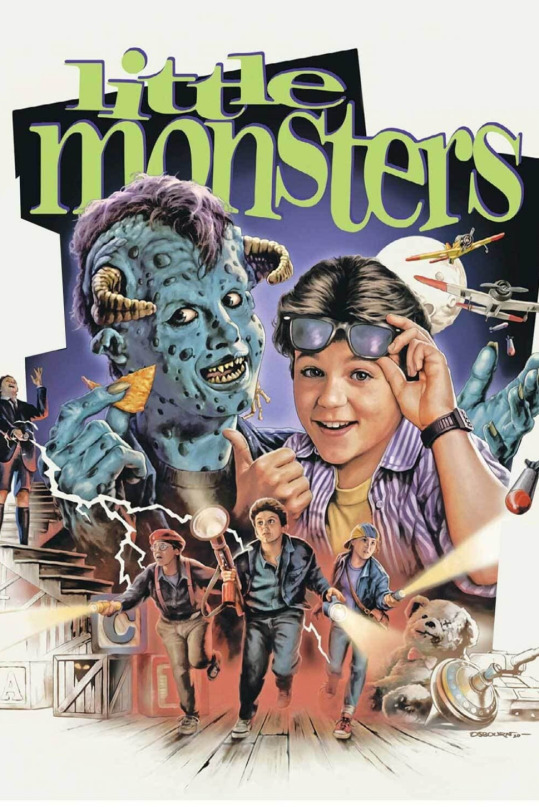
#movies#polls#little monsters#little monsters 1989#little monsters movie#80s movies#richard greenberg#fred savage#howie mandel#daniel stern#requested#have you seen this movie poll
80 notes
·
View notes
Text

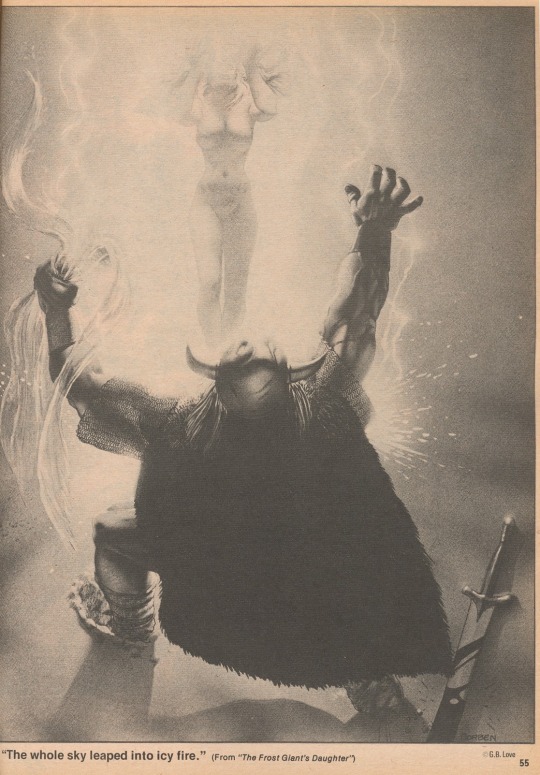

The Corben Conan, Savage Sword of Conan #4, February 1975
59 notes
·
View notes
Text
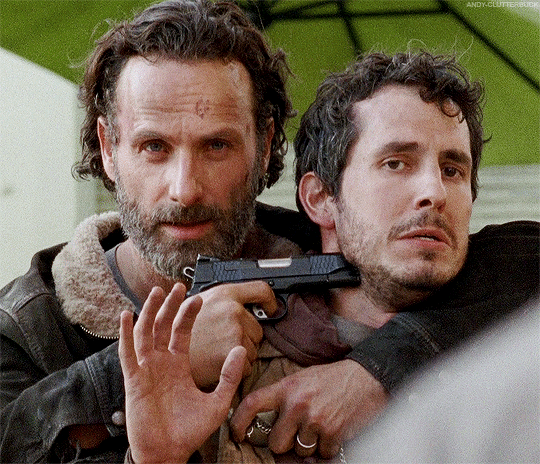
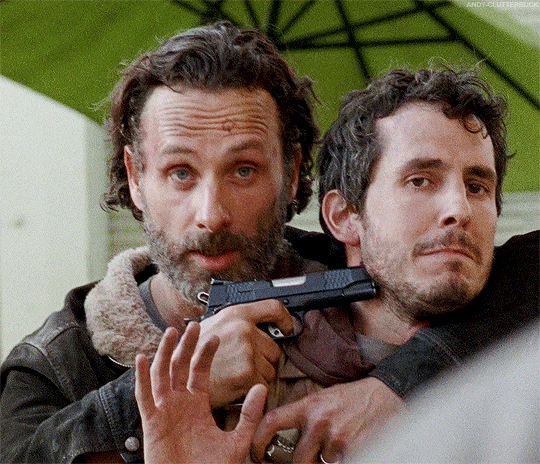


4x16 | A
#richard pls#Rick Grimes#*#rg#S4#cool me next#glaring savage wild rick#sign me up#if i lay here#if i just lay here#you could step on me and that'd be ok#look at me like that thanks#obviously not while you're holding a dude hostage but ya know#i wouldn't be adverse if that was the only way
191 notes
·
View notes
Photo



Lily’s Movie Challenge (12/370): Do The Right Thing (1989)
#can't even review this film it's just that good#an excellent rewatch for the challenge#spike lee#do the right thing#november 2022#lmc#danny aiello#ossie davis#ruby dee#richard edson#giancarlo esposito#rosie perez#martin lawrence#bill nunn#john turturro#john savage#samuel l jackson#film#cinema#movie#gifs#my gif
471 notes
·
View notes
Note
Could I hear more of your thoughts on Doc Savage and the archetype he created? How does it relate to modern superheroes more specifically Reed Richards? (I know that you dislike Doc Savage, so sorry if this bothers you.)
Sorta like this, if we take a look at how Doc's archetype was formed and consolidated, and how that affected the Superheroes and Reed Richards specifically. (also please don't apologize, you all can ask me questions about whatever, seriously)

"Doc Savage" is recognizable in lots of other characters but there is a difference between specific pastiches or tributes or parodies of Doc (Doc Samson, Edison Rex, Jonas Venture), and characters who are evoking Doc Savage as his own archetype to draw initial inspiration from (Tom Strong, Bane, Clark Kent), and if we pull at Doc's roots we're gonna get to prior characters like Tarzan and Sherlock who were the ones to introduce or codify much of what are now commonplace superhero traits or the ones to introduce much of what Doc was originally pulling from.
I wanna draw some lines in the sand separating what is it that these characters brought to the table, in the road to get to Reed Richards and what exactly is it that Reed and Doc have in common vs things they have that are mainly taken from characters before them/grandfathered in their respective mediums. So let's go over the Archetypes here:
The Sci-Fi Superman: Coined by Peter Coogan. Through some strange birth or scientific intervention, these characters have superhuman powers and abilities that set them irrevocably apart from humanity, nearly forcing them to usually fall into the roles of saviors, rulers, destroyers, or ostracized/self-imposed hermits. Unless they find a purpose requiring said abilites, they cannot be permitted to exist and usually meet a tragic demise or is stripped of said power. Formative example is The Creature from Frankenstein (Mary Shelley), and others include Hugo Danner from Gladiator (Phillip Wylie) and Bill Dunn from The Reign of The Superman (Jerry Siegel). Coogan considers John Carter the first wholly positive and heroic SF superman, which is disputable, but more on Carter later.
Pulp Ubermensch: The Great Man turned do-gooding adventurer with a prosocial agenda. A human who is physically, mentally, and/or morally superior to those around him as a result of training/upbringing, skilled at everything the story requires him to, who applies his talents and abilities near-exclusively to fight evil. Formative example is Nick Carter (created by John R. Coryell and penned by Frederick Van Rensselaer Dey), who established much of what would eventually become pulp hero and superhero convention consequently.
The Great Adventurer: I'm naming these as a counterpoint to The Great Detective, the fantastical globetrotting adventurer/explorer hero who can go anywhere and do anything, who takes to the world as the detective takes to the city. The idea of a wealthy, offbeat, yet good-natured pulp hero who goes around righting wrongs with like-minded assistants. Formative example here is Rocambole (Ponson du Terrail), in most ways a definitive early Pulp Ubermensch, and arguably the first proto-superhero to assemble a gang of odd companions with a variety of talents and backgrounds to aid him, which is what both the Fabulous Five and the Fantastic Four can trace roots back to.
Pulp Supermen: Offshoots of the Sci-Fi Superman as adventure protagonists in serialized stories, where their superhuman natures and status are alleviated and redirected by the need of their capabilities somewhere or in service of something, and thus they get around the ruler/savior/destroyer fate by being heroes with a social calling akin to the Pulp Ubermensch, dedicated to use their powers near-exclusively to fight injustice without rocking the boat of society by their presence (or if necessary, assert dominion ONLY in a setting outside of human society, such as the jungle or Martian civilization). Distinguished from the Pulp Ubermensch by their greater larger-than-life explicitly superhuman abilities, that they don't need to be morally/mentally superior to the extent of a Pulp Ubermensch, and by the fantastical settings and tone of their adventures. Formative examples are John Carter of Mars and Tarzan of the Apes (both created by Edgar Rice Burroughs), with Tarzan quoted by Lester Dent as a specific influence on Doc (there are others but we're skipping most of those not relevant here)
The Science Adventurer: A frequently-used name to describe Doc Savage and Doc Savage-alikes. Doc Savage can be described, in archetype word salad terms, as a Pulp Superman who calls upon the Pulp Ubermensch's great man-ness and urban social calling, and who combines a Sci-Fi Superman origin and physical traits with The Great Adventurer's explorer disposition, righteousness and band of companions. The main thing that sets him apart from the characters listed prior is his focus on scientific prowess, technology, reasoning and polymathic skills, the importance of the "Doc" part of his name as it where.
The Superhero: you already know what these are and how they relate to the above. I've written a couple of things about the differences between pulp heroes and superheroes and it's a subject I'm of constantly mixed opinions on even regarding stuff I wrote, so I'm linking these two written a year apart if you want an idea of where those differences are.
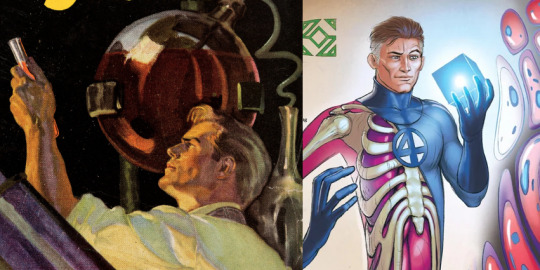
And so we get to Reed, who I'm naming a Science-Adventurer Superhero as a merger of the last two. Both Stan Lee and Jack Kirby mentioned several times that they read Doc Savage aplenty during the Depression and it shows in elements such as the Baxter Building (an expansion of Doc's headquarters in the Empire State Building - instead of just the 86th floor, The Four get the entire skyscraper), the specialized aircraft and vehicles, the fights and antagonism between the cantankerous and anti-social Ben Grimm and the smart-mouthed Johnny Storm mirroring the bickering spats between the bestial Monk and the silver-tongued Ham, and of course Beast from X-Men being more closeled modeled on Monk's ape-ish traits and scientific expertise (there's a fairly large argument to be made, that I think accounts for some of why Beast is, like that, in recent comics, that Ben Grimm and Hank McCoy both divided Monk Mayfair's every trait between themselves and ultimately flipped the script in the long run before taking it to the farthest extremes possible as polarized opposites of each other, with Ben initially getting most of the bad parts and making them the best ones, and Hank initially getting all the good ones and making them into the worst ones)
As far as I know, Reed Richards was not consciously modeled after Doc Savage (although Jack Kirby and Joe Simon's Private Strong used the origin story of a professor raising his son in a lab to be perfect in total isolation of other humans, which Lester likely may have pulled from Phillip Wylie's The Savage Gentleman to begin with), although it's commonly said that the direct precursors of the Four, the Challengers of the Unknown, were modeled after Doc Savage and the Fabulous Five's make-up. The members of the Fantastic Four are all based on 50s sci-fi archetypes, with Reed as the quintessential scientist, the grey-templed pipe-smoking patriarch frontman of the expeditions, and some creators over the years seem to have drawn upon Doc Savage as a model Reed. I'm thinking specifically of Mark Waid here, who openly named Doc Savage in his pitch bible:
The eternal problem with Scientifically Inclined Genius Adventures, the reason they don't ring true, is because in real life scientists spend all their damn time in the lab. Not Reed.
F'r pete's sake, we know he undertook all sorts of Indiana Jones missions as a younger man, we've seen that he actively enlisted in a war, and oh yeah, he stole a rocketship and tried to take it to the moon."
Tommy B put his finger on it when he suggested I stop thinking of Reed as the Professor from Gilligan's Island and instead think of him more like Doc Savage. When Reed encounters mental or logistic obstacles in his quest for knowledge, he thinks through them.
Doc Savage, of course, isn't the perfect model - he's a little more blood-and-gristle than Reed, more invested in the search for justice than for knowledge, and a little more "in the moment" as a general rule. Reed's more like Peter Weller as Buckaroo Banzai, they have the same aloof, detached nature. Unless active danger is staring him right in the face, Reed often seems a bit distant and not completely here because his mind is ten minutes in the future.
That addresses the Science-Adventurer aspect, which leaves us with the Superhero side of the equation.

With Doc Savage you of course have one of the, if not the, main archetypal pulp heroes, a character that both Superman and Batman would take a great deal from, and "pulp hero" in itself is a term that exists to define these characters more so in relation to superheroes than what they were actually like in their own stories, time periods and mediums. The superhero as a concept is founded on Superman and Batman and their dychotomy. Costumed Avenger vs Ubermensch, mortal and immortal, light and dark, Dayman and Nightman (AHH-ahhh-AAHHHHH!), and that dynamic is specifically a result of Superman and Batman being direct descendants from Doc Savage and The Shadow respectively, who were Street & Smith's (and by extension the American pulps) Big Two, the top dogs of 1930s hero pulps, and direct opposites to each other.
Doc Savage was created in response to The Phantom Detective (who was the first successful Shadow imitator and thus defined it as the thing everyone was gonna have to do or respond to) and was in many ways a modernized revamp-almost-copy of Street & Smith's Nick Carter during his heyday, in origin and first case and super strength and omnicapable skills and general Great Man-ness and gadgetry and mission statement and so on. Doc was co-created by the editor of Nick Carter Magazine, John Nanovic, and the first response to the Phantom Detective that S&S planned was a reboot of Nick Carter as a generic hardboiled detective, published on March 1933, the same month as Doc's debut, and obviously Doc would go on to achieve much greater success and thus would popularize those traits again with himself as the figurehead archetype of them (not unlike what Superman and Batman would later do).
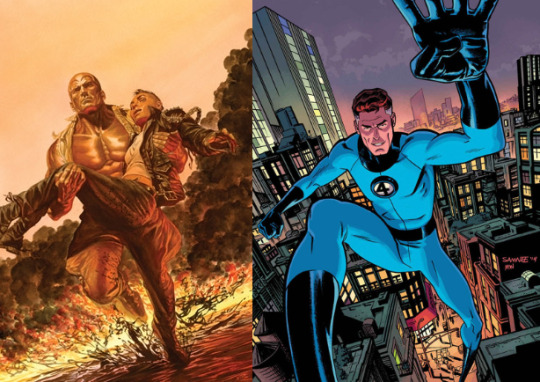
Unlike The Shadow, Doc Savage does not operate under a secret identity or mask. He is not the hidden master of the city and has no division between his alter egos, and because he performs in broad daylight as a celebrity, is theorically held to social scrutiny, and is fully sanctioned and approved by law enforcement and works with the authorities with public transparency (minus the crime college but let's just, not, for now), it greatly upends and affects the approach he takes to fighting crime. He only has one identity, the greatest man of all time as the stories will remind you at every turn, by his author's own words he "manifests Christliness", and while not much separates Doc Savage's skills from Nick Carter's, he is explicitly and textually framed as superhuman (even a "superman", that term was deployed a few times), and he operates in a contemporary, urban setting that most Pulp Supermen cannot touch without veering into Sci-Fi Superman territory.
Within the hero pulp format that S&S started with Nick Carter and renewed with The Shadow, with the scientific explorer angle, you could argue Doc Savage, in almost exactly the same way as he does in his stories, worked out the solution to an unfixable problem: Turns out you can be as over-the-top super as you want, so long as you have a procession of equivalent super menaces to fight, don't upset society (and if you do it, not where the public where can see, keep it a secret that you can be blackmailed over by crooks you will inevitably silence okay look I'll stop now), have whatever incredible miracle cures and achievements and charity you do work on take place off screen where you never have to deal with them too seriously, and know how to pick your fights.
His service to others resolves the ruler/savior/destroyer conundrum. Savage aids individuals who face problems beyond their control, does great work in advancing medicine and science, and alleviates suffering through charity work, but he leaves the institutions of society in place.
He faces a never-ending succession of villains threatening society, an eternal frontier of gangsters and super-scientific menaces who play the role that Indians take in frontier narratives. The unresolvable nature of crime makes this frontier eternal, so Savage can place his superiority in service to the community and never risk turning into a ruler, savior, or destroyer because he can find challenges sufficient to absorb his energies.
The Savage solution—the hero position would be adopted by the creators of other prosocial supermen to come, including Superman, although only the adventures of Superman would be set in contemporary America.
Thus instead of marking an end to the bourgeois domination of society, as Nietzsche foresaw, the superman serves to protect that domination through myth-narratives. - Superhero: The Secret Origin of a Genre, by Peter Coogan

Reed Richards, in turn, is defined (INCORRECTLY, I say, feeling a plasma crackle barely miss my skull) as the smartest man on the planet, a mental superhuman who operates on a level above and beyond that of everyone around him, and a freak accident during a space travel grants him physical superhumanity to match, with his body able to morph and bend under his will. He alleviates the ruler/savior/destroyer conundrum Coogan described in much of the exact same way described above, kept busy with an endless procession of strange dimensions and aliens and supervillain challenges, and Mark Waid's famous confession scene in Fantastic Four #489 addresses the fate that looms over the Sci-Fi Superman directly, with the "very arrogant man who did something very stupid" pointificating to his toddler child just how necessary it was to ensure that the world would not fear and destroy the people he'd irreversibly mutated as a result of hubris, what is even the point of his grandstanding title and colorful outfit and public adventures and all that.

The life of superpowered adventurer celebrities was a necessity, and his superhero persona, Mr Fantastic, is a tabloid-catching act of penitence to mask his ultimate shame and to compensate the people he loves most. He lives for science, he craves discovery above all, but as far back as the Lee/Kirby stories, he still drags the team into awful intrusive press conferences none of them want to go but must, he sits through meetings with hardass generals to buy his team more leeway and trust, he takes the time to stretch across the city to visit sick children in hospitals and say hello to passing helicopters, he has to be the stick-in-the-mud dad who stretches himself thin to keep Johnny and Ben from ditching the team or seriously hurting each other (those first Johnny and Ben spats get way more violent than you'd expect), and he has to make difficult and even manipulative and harsh decisions even then to save the most lives he can. He carries a responsability to his family and loved ones first and foremost, and fashioning himself and them into superheroes is how he lives up to that responsability. It's what allows them to exist and thrive in-universe as much as out of it.
(We're not gonna play catch-up to the "why doesn't Reed Richards cure cancer" conversation but even that, in itself, is an extension of a thread that we can trace back to Doc and the Sci-Fi Supermen before him, when seams in the fantasy start showing with the introduction of consequence, a trend that particularly catches up to these scientist superhero characters who followed in Doc Savage's wake, and obviously caught up to Doc himself several times by now, for reasons @artbyblastweave describes as "a consequence of contemporary writers being Allowed To Notice And Unpack Things" and elaborates on very neatly here)
As a superhero, Reed Richards exists in conversation with Superman and Batman, same as every other character within the superhero "genre", which means he also exists in conversation with those traits borrowed from Doc Savage, and The Shadow, and all these other guys listed who were crucial in their development and a lot of others I'm leaving out of the conversation for now. A crucial part of that conversation and where the Fantastic Four figure into it is the fact that they were designed to not be traditional superheroes but to flip most if not all the conventions established on it's head, a part of that being their initial lack of uniforms (and when they did get uniforms they were just that, uniforms, rather than costumes), the lack of a secret identity, and the fact that the Four are scientists and explorers first, and crimefighting superheroes a distant second they're forced to frequently make a close second or first priority. Marvel made it's big defining pop culture splash with the Fantastic Four by turning superhero convention on it's head and doing as much as they could to do the opposite of what Brand Echh was doing.
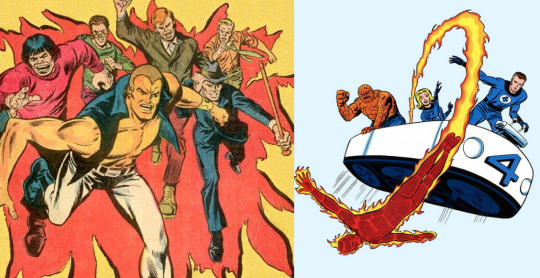
And that's kinda the main reason they end up inviting similarities with Doc Savage and other pulp heroes, because they're going out of their way to imitate and subvert traits and tropes that Superman and Batman were already imitating and subverting from those guys in the first place, that they in turn were imitating and subverting from guys that came before them, and etc.
Archetypes are breakthroughs, and no breakthrough happens in a vacuum. In the end, a lot of these strands and connections between these characters are less specifically the result of writers consciously following in the footsteps of Doc Savage and those that came before or alongside him, and more so with the fact that there's only so many left turns you can take before you just end up in a circle, or reinventing the wheel as it were.

#replies tag#pulp heroes#pulp fiction#superheroes#marvel#marvel comics#doc savage#lester dent#reed richards#fantastic four#stan lee#jack kirby#mark waid#comics
69 notes
·
View notes
Photo
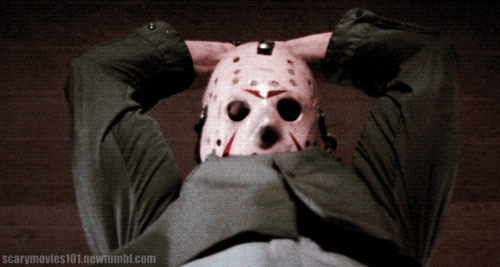
Jason Voorhees
#jason voorhees#friday the 13th#friday the 13th part 3#richard brooker#Jeffrey rogers#nick savage#amy steel#steve dash#my gifs#80s horror#horror movies#cinema#horror#movies#movie gifs#gif#gifs#friday the 13th part 2#80s#1980s
494 notes
·
View notes
Text
#there’s not enough Isa polls#injustice society of america#henry king sr#per degaton#joar mahkent#the shade#richard swift#vandal savage#sportsmaster#huntress#jsa#justice society of america
21 notes
·
View notes
Text




The new Conan the Barbarian series is off to a great start! Don’t miss it!
#Conan#conan the destroyer#conan the barbarian#titan comics#robert e howard#king conan#jim zub#roberto de la torre#jose villarrubia#richard starkings#savage sword of conan
64 notes
·
View notes
Text
🍷Sorry, He Would, Though🍷
Gabriel: *at a bar, as Balthazar's wingman, pointing out a lady to his little brother*
Balthazar: *speaking loud enough for the whole bar to hear* I wouldn't fuck that!
Gabriel: *curls over in laughter, having forgotten that this brother in particular is, well, gay*
Balthazar: *in a low voice* Now, that fine gentleman over there, I might- *glances at Sam*
Gabriel: Oh, Hell no! He's mine! You can have Dean.
Balthazar: I'd rather not. Is Adam available?
Gabriel: No, he's Michael's. But I do know a single British guy who could use a good hook up.
Balthazar: What's his name?
#im not shipping unless youre talking about sabriel#but this would happen and you know it#supernatural#archangels#seraphims#sabriel#midam#destiel#gabriel would make a fine wingman#balthazar is savage af#gabriel#richard speight jr#balthazar#sebastian roche#spn incorrect quotes#again not shipping#unless its destiel sabriel or midam#please dont ship the others#not that i have a control over this fandom#eh whatever
139 notes
·
View notes
Text
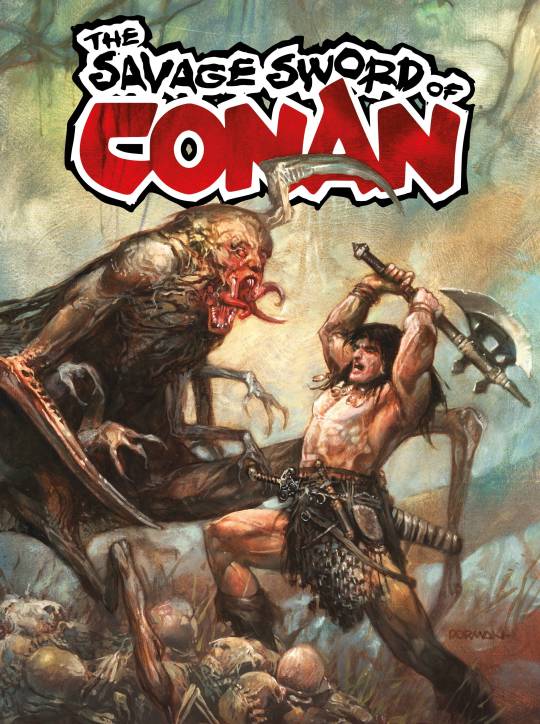
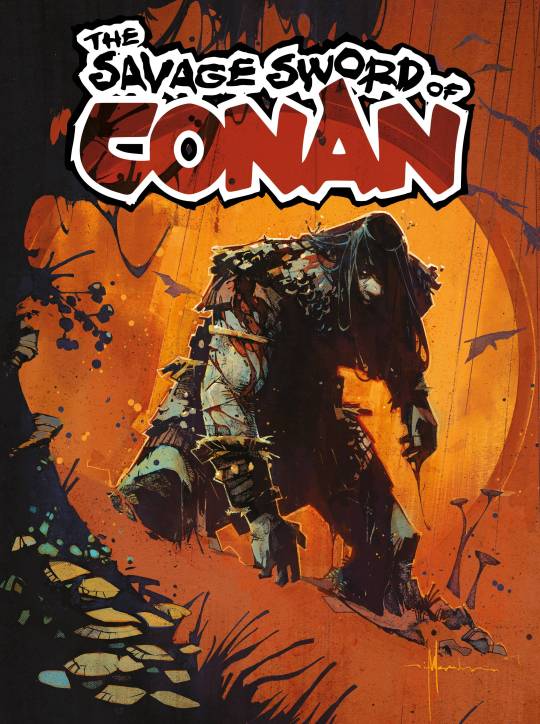
The Savage Sword of Conan #2 by Jim Zub, Richard Pace and Patrick Zircher. Cover by Dave Dorman. Variant cover by Nick Marinkovich. Out in April.
"THE RETURN OF A CULT CLASSIC TITLE!
THE SAVAGE SWORD OF CONAN continues its triumphant return from Heroic Signatures and Titan Comics!
Featuring a new CONAN epic from writer Jim Zub and artist Richard Pace, the exciting continuation of writer/artist Patch Zircher's SOLOMON KANE tale, spectacular covers from Dave Dorman and Nick Marinkovich, jaw-dropping art pin-ups, and more, THE SAVAGE SWORD OF CONAN Issue #2 is an onslaught of awe-inspiring adventure."
#the savage sword of conan#savage sword of conan#conan#conan the barbarian#titan comics#jim zub#richard pace#patrick zircher#patch zircher#dave dorman#nick marinkovich#variant cover#comics
18 notes
·
View notes
Text
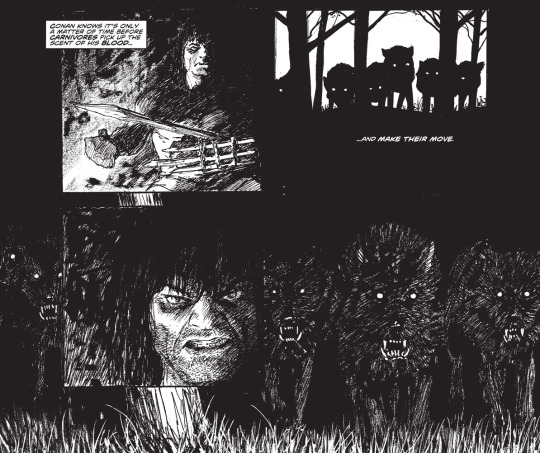
from ' Leaving The Garden ' Savage Sword of Conan written by Jim Zub art by Richard Pace
13 notes
·
View notes
Text
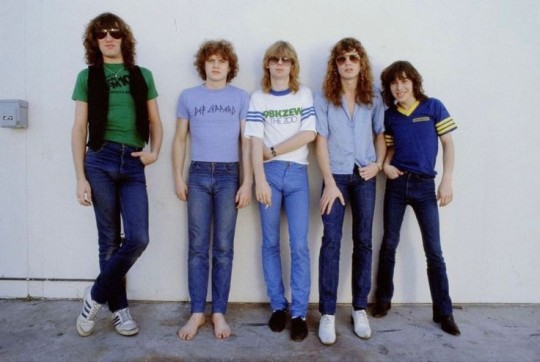

#WHAT THE FUCK RICHARD#def leppard#joe elliott#rick allen#steve clark#rick savage#pete willis#baby leps
23 notes
·
View notes
Photo
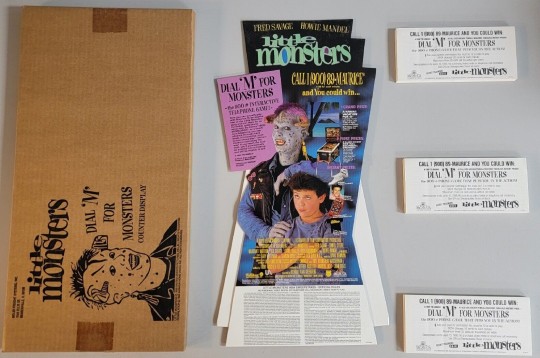
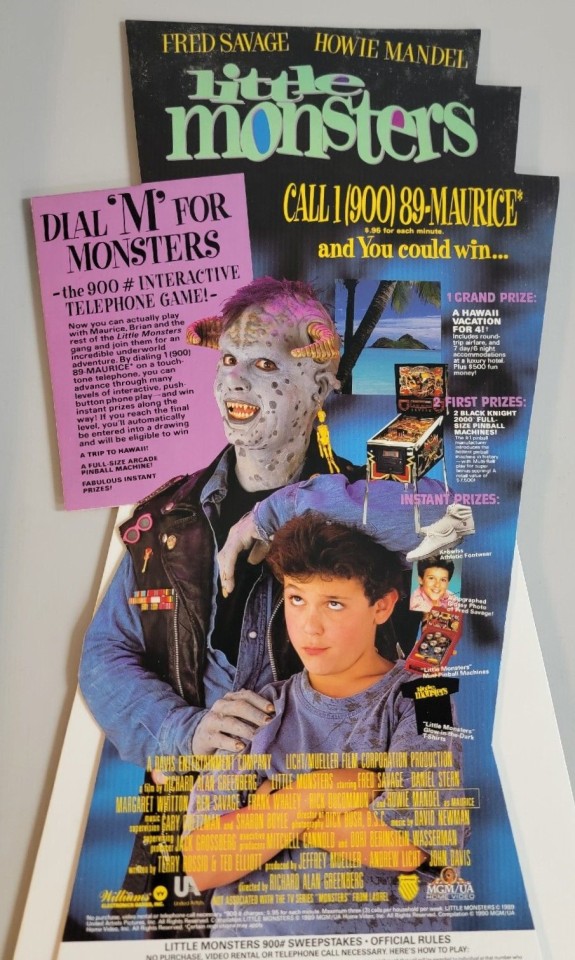




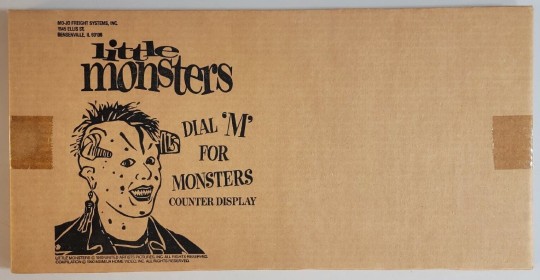
30 notes
·
View notes
Text
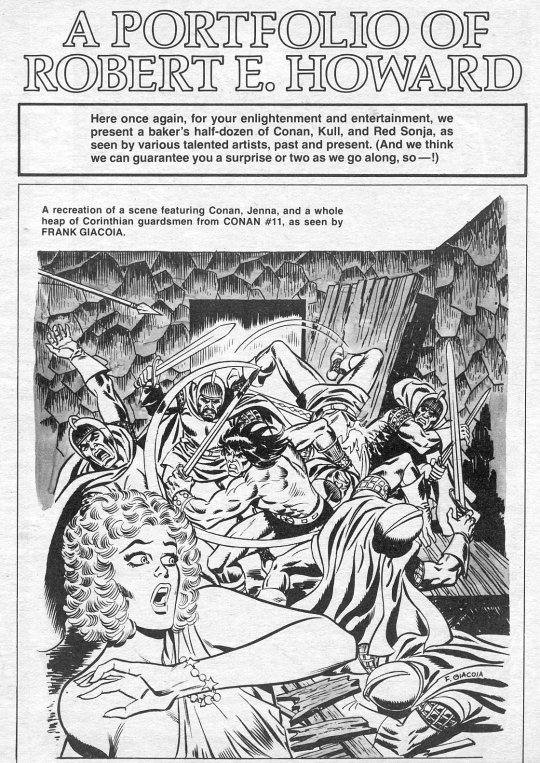


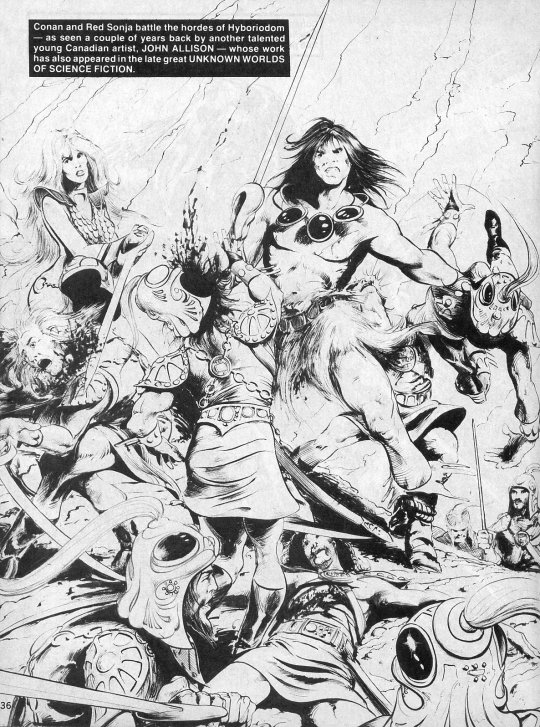


The Savage Sword of Conan the Barbarian #16 -December 1976
A Portfolio of Robert E. Howard
art page 1 Frank Giacoia
art page 2 Gene Day
art page 3 John Buscema, inked by Tim Conrad
art page 4 John Allison
art page 5 Virgil Finlay
art page 6 Richard Corben
art page 7 Roy G. Krenkel
#the savage sword of conan the barbarian#Conan#robert e. howard#frank giacoia#gene day#john buscema#tim conrad#john allison#virgil finlay#richard corben#roy g. krenkel#comic art
27 notes
·
View notes
Text








The Hunter (1962, Richard Stark) || His Name Is... Savage! (1968, Gil Kane & Archie Goodwin) || The Hunter (2009, Darwyn Cooke)

Gil Kane's Savage is resolutely visually based on Lee Marvin in Point Blank (1967) -- in itself a loose adaptation of Richard Stark's debut Parker novel, even if not a single line of dialogue from the book appears in the film -- but before Darwyn Cooke's incredible graphic novel adaptation, it's worth noting that the eponymous Savage can easily be read as a proto-comic book Parker. In fact, more than a couple moments in the Kane-Goodwin classic quite explicitly call back to Stark's novel much more than Point Blank ever does.
#his name is savage#his name is... savage!#parker#richard stark's parker#darwyn cooke#richard stark#gil kane#archie goodwin#point blank#lee marvin#comic book history#(in a manner of speaking)#u can reblog
5 notes
·
View notes